
The United Australia Party (UAP) was an Australian political party that was founded in 1931 and dissolved in 1945. The party won four federal elections in that time, usually governing in coalition with the Country Party. It provided two prime ministers: Joseph Lyons (1932–1939) and Robert Menzies (1939–1941).

The Nationalist Party, also known as the National Party, was an Australian political party. It was formed in February 1917 from a merger between the Liberal Party and the National Labor Party, the latter formed by Prime Minister Billy Hughes and his supporters after the 1916 Labor Party split over World War I conscription. The Nationalist Party was established as a 'united' non-Labor opposition that had remained a political trend once the Labor party established itself in federal politics. The party was in government until electoral defeat in 1929. From that time it was the main opposition to the Labor Party until it merged with pro-Joseph Lyons Labor defectors to form the United Australia Party (UAP) in 1931. The party is a direct ancestor of the Liberal Party of Australia, the main centre-right party in Australia.
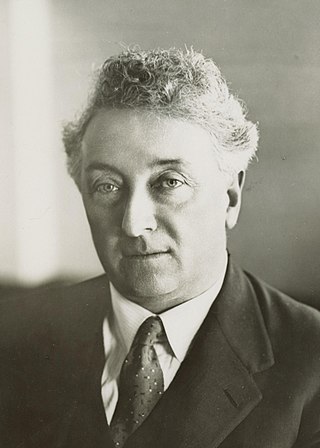
Joseph Aloysius Lyons was an Australian politician who was the tenth prime minister of Australia, in office from 1932 until his death in 1939. He began his career in the Australian Labor Party (ALP), but became the founding leader of the United Australia Party (UAP) after the Australian Labor Party split of 1931. He had earlier been 26th premier of Tasmania from 1923 to 1928.
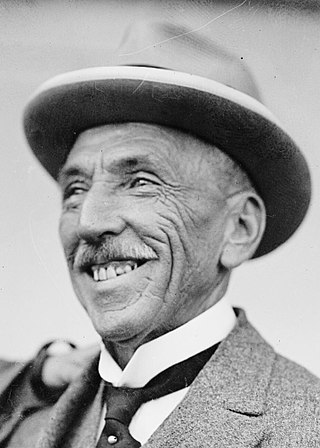
William Morris Hughes was an Australian politician who served as the seventh prime minister of Australia from 1915 to 1923. He is best known for leading the country during World War I, but his influence on national politics spanned several decades. Hughes was a member of federal parliament from Federation in 1901 until his death in 1952, the only person to have served for more than 50 years. He represented six political parties during his career, leading five, outlasting four, and being expelled from three.

James Henry Scullin was an Australian politician and trade unionist who served as the ninth prime minister of Australia from 1929 to 1932. He held office as the leader of the Australian Labor Party (ALP), having briefly served as treasurer of Australia during his time in office from 1930 to 1931. His time in office was primarily categorised by the Wall Street Crash of 1929 which transpired just two days after his swearing in, thus heralding the beginning of the Great Depression in Australia. Scullin remained a leading figure in the Labor movement throughout his lifetime, and was an éminence grise in various capacities for the party until his retirement from federal parliament in 1949. He was the first Catholic, as well as the first Irish-Australian, to serve as prime minister.

The Liberal–National Coalition, commonly known simply as the Coalition or the LNP, is an alliance of centre-right political parties that forms one of the two major groupings in Australian federal politics. The two partners in the Coalition are the Liberal Party of Australia and the National Party of Australia. Its main opponent is the Australian Labor Party (ALP); the two forces are often regarded as operating in a two-party system. The Coalition was last in government from 2013 to 2022. The group is led by Peter Dutton, who succeeded Scott Morrison after the 2022 federal election.

Sir Bertram Sydney Barnsdale Stevens, also referred to as B. S. B. Stevens, was an Australian politician who served as the 25th Premier of New South Wales, in office from 1932 to 1939 as leader of the United Australia Party (UAP).

Edmond John "Ned" Hogan was an Australian politician who was the 30th Premier of Victoria. He was born in Wallace, Victoria, where his Irish-born parents were small farmers. After attending a Roman Catholic primary school, he became a farm worker and then a timber worker, and spent some time on the goldfields of Western Australia.

Reginald Walter Darcy Weaver was an Australian conservative parliamentarian who served in the New South Wales Legislative Assembly for 28 years. Serving from 1917 in the backbenches, he entered the cabinet of Thomas Bavin in 1929 as Secretary for Mines and Minister for Forests until he returned to opposition in 1930. Following the success of the United Australia Party in the 1932 election, Weaver returned as the Secretary for Public Works and Minister for Health in the Stevens ministry.

The 1931 Australian federal election was held on 19 December 1931. All 75 seats in the House of Representatives and 18 of the 36 seats in the Senate were up for election.
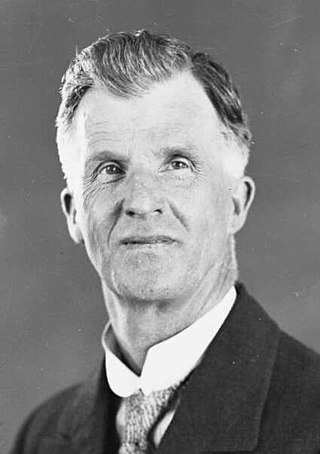
The 1929 Australian federal election was held in Australia on 12 October 1929. All 75 seats in the House of Representatives were up for election, but there was no Senate election. The election was caused by the defeat of the Stanley Bruce-Earle Page Government in the House of Representatives over the Maritime Industries Bill, Bruce having declared that the vote on the bill would constitute a vote of confidence in his government.

The 1919 Australian federal election was held on 13 December 1919 to elect members to the Parliament of Australia. All 75 seats in the House of Representatives and 19 of the 36 seats in the Senate were up for election. The incumbent Nationalist Party government won re-election, with Prime Minister Billy Hughes continuing in office.

Sir Robert Archdale "Archie" ParkhillKCMG was an Australian politician who served in the House of Representatives from 1927 to 1937. He began his career in politics as a campaign director for the Commonwealth Liberal Party and Nationalist Party. He later joined the new United Australia Party in 1931, and served as a minister in the Lyons government between 1932 and 1937.
This article provides information on candidates who stood for the 1931 Australian federal election. The election was held on 19 December 1931.
This is a list of members of the Australian Senate from 1929 to 1932. Half of its members were elected at the 14 November 1925 election and had terms starting on 1 July 1926 and finishing on 30 June 1932; the other half were elected at the 17 November 1928 election and had terms starting on 1 July 1929 and finishing on 30 June 1935. The process for filling casual vacancies was complex. While senators were elected for a six-year term, people appointed to a casual vacancy only held office until the earlier of the next election for the House of Representatives or the Senate.

The Lyons government was the federal executive government of Australia led by Prime Minister Joseph Lyons. It was made up of members of the United Australia Party in the Australian Parliament from January 1932 until the death of Joseph Lyons in 1939. Lyons negotiated a coalition with the Country Party after the 1934 Australian federal election. The Lyons government stewarded Australia's recovery from the Great Depression and established the Australian Broadcasting Corporation.
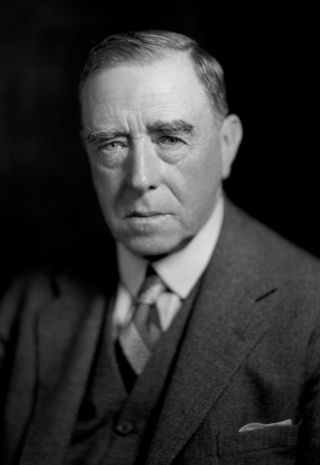
The 1932 Victorian state election was held in the Australian state of Victoria on Saturday 14 May 1932 to elect 44 of the 65 members of the state's Legislative Assembly. The other 21 seats were uncontested.
The Victorian Labor Party, officially known as the Australian Labor Party and commonly referred to simply as Victorian Labor, is the Victorian state branch of the Australian Labor Party (ALP). The branch is currently the ruling parting in the state of Victoria and is led by Jacinta Allan, who has served concurrently as premier of Victoria since 2023.
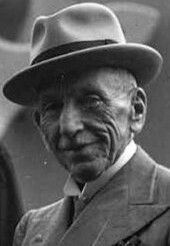
The United Australia Party (UAP) held a leadership election on 9 October 1941, following the resignation of Robert Menzies on the same day. Billy Hughes was elected as his replacement.
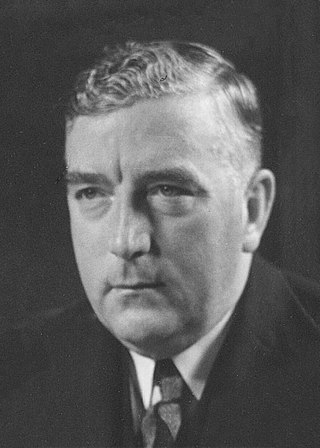
The United Australia Party (UAP) held a leadership election on 22 September 1943, following the resignation of Billy Hughes. Robert Menzies, the party's leader from 1939 to 1941, was elected as his replacement, defeating three other candidates – Thomas White, Allan McDonald, and Percy Spender.

















